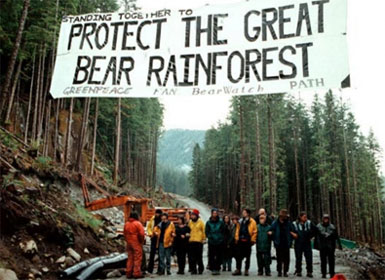In a landmark day for conservation, 20 years of work has been fulfilled in British Columbia, as much of the world’s largest temperate rainforest finally receives full protection.
Stakeholders – including the logging industry – agreed to protect 85% of Great Bear Rainforest – 3.1 million hectares. The other 15% of this coastal temperate rainforest will be open to industrial logging, subject to the most stringent standards in North America. The moss-covered, old growth forest is the size of Nova Scotia.
Back in 2006, a third was protected, after blockades and boycotts of lumber products, which brought companies to the negotiating table. Until then, "almost every valley of Great Bear was slated for clear cutting," says World Wildlife Fund-Canada.

With trees 1000 years old, Great Bear is among the most pristine wilderness left on earth, stretching 250 miles along BC’s central and north coast. Lush forests range from glacier-capped mountains to the coast, where a labyrinth of fjords harbor marine life from whales and dolphins to sea otters and sea lions. This is wild salmon country, where grizzly bears gorge as they did for thousands of years, and wolves roam unfettered by man.
The agreement is between First Nations, British Columbia and five logging companies, with the support of ForestEthics, Greenpeace and Sierra Club BC.
"A milestone for collaboration between governments, environmental organizations and forestry companies," it provides economic certainty to loggers, while protecting biodiversity and mitigating climate change.
"The Great Bear Rainforest Agreements is one of the most visionary forest conservation plans on Earth," says Valerie Langer, ForestEthics Solutions Director. "It is a principled approach that sets a new legal and science-based standard for sustaining healthy forests and maintains intact, old-growth that will keep millions of tons of carbon out of the atmosphere."
Great Bear is home to 26 First Nations tribes, which will finally have oversight of their own land. One of their first decisions is to end trophy hunting of grizzly bears.

"This should give hope to other areas in the world that are currently in conflict, that those conflicts can move towards collaboration and eventually to conservation and economic prosperity and well-being for communities," Richard Brooks of Greenpeace told CBC News.
The next step is to protect the Great Bear Sea, one of the richest cold-water seas in the world, notes World Wildlife Fund-Canada. Virtually unprotected, it remains healthy and productive, but faces growing pressure from increased human activity. "Better planning and marine protection is needed in the face of proposed oil and gas pipelines, increased shipping, growing port construction and other industrial activities."
Last year, First Nations and British Columbia signed the Marine Planning Partnership (MaPP) agreement, which protects over 102,000 square kilometres of coastline. But federal agencies that regulate commercial fishing and shipping are not included. It’s crucial that legislation be passed to ban tankers to discourage oil and gas pipelines from being planned through this sensitive region, says WWF-Canada.
The silence of Great Bear is striking, says National Observer. "We don’t usually think of silence having presence. But to sit in one of the great valleys of the Great Bear Rainforest is to be enveloped by a silence so powerful it shakes your very sense of self. It is a primordial silence you feel right into your bones; a silence that feels even more ancient than the gnarled cedars that have loomed in the mist through the rise and fall of so many civilizations and human empires."
Several years ago, Manitoba protected the heart of the Boreal Forest and the Canadian Boreal Forest Agreement was signed by environmental groups and 21 of Canada’s largest forestry companies.
Read our article, No End To Greed: Tar Sands Expands Into Crucial Caribou Habitat.
Read more about the Great Bear agreement and how it came about:
